Agile methodologies have become the go-to approach for product development teams aiming to deliver high-quality results efficiently. At the heart of these methodologies lies Scrum, a powerful framework that breaks down complex projects into manageable chunks. Central to Scrum are two key concepts: sprints and Scrum artifacts. But what exactly are these, and how can they revolutionize your product development process?
Sprints are time-boxed periods where teams focus on delivering specific increments of work, while Scrum artifacts provide crucial information and transparency throughout the process. Together, they form the backbone of the Scrum framework, enabling teams to maintain focus, adapt quickly, and consistently deliver value.
In this article, we’ll explore how Scrum sprints and Scrum artifacts can supercharge your team’s productivity, and how tools like monday dev, an end-to-end product development management platform, can streamline your sprint management and enhance your use of Scrum artifacts at every stage of your product lifecycle.
Try monday devWhat is a Scrum sprint?
A Scrum sprint is a fixed time frame, typically lasting 1-4 weeks, during which a Scrum team works to complete a set amount of work. Think of it as a mini-project within your larger product development effort. The goal? To create a potentially shippable product increment by the end of each sprint, guided by key Scrum artifacts.
Key elements of a Scrum sprint include:
- Sprint goal: A clear, concise objective that gives the team a shared purpose for the sprint.
- Sprint backlog: A Scrum artifact that lists tasks and user stories the team commits to completing during the sprint.
- Daily Scrum: Brief daily Scrum meetings where team members sync up on progress and obstacles.
- Sprint review: A demonstration of the completed work to stakeholders at the sprint’s end.
- Sprint retrospective: A team reflection on what went well and what could be improved.
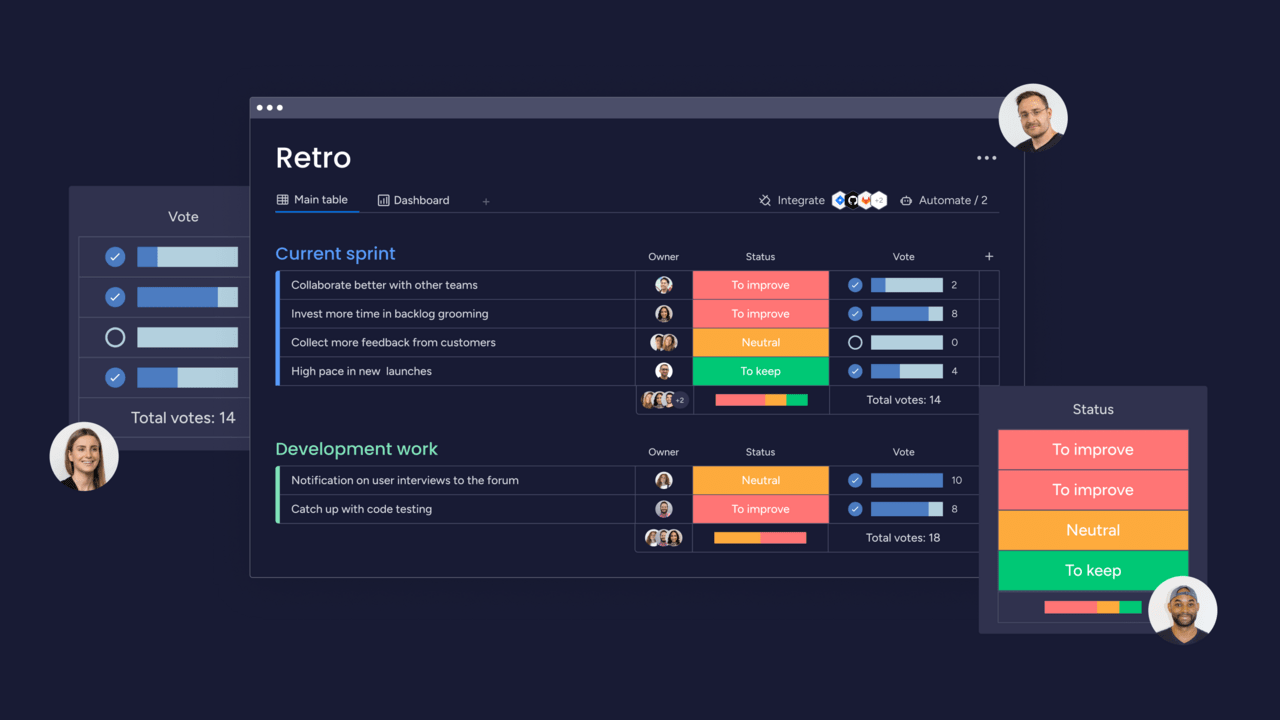
Understanding Scrum artifacts
Scrum artifacts are essential tools that help teams visualize work, provide transparency, and enable continuous improvement.
Here are the three primary Scrum artifacts crucial for managing each sprint effectively:
- Product backlog: This is the master list of tasks that needs to be done, the single source of truth — managed by the Product Owner. It includes everything from new features and bug fixes to technical tasks and knowledge acquisition.
- Sprint backlog: Derived from the Product Backlog, this artifact contains all tasks selected for the current sprint. It’s a more focused list that the development team commits to completing, serving as a roadmap for the sprint’s goals.
- Increment: This is the sum of completed items from the Sprint Backlog, adding up to a potentially shippable version of the product. It’s the concrete output of a sprint, showcasing tangible progress towards the project goals which should roll up to business goals.
By keeping these artifacts clear, updated, and accessible, teams can ensure that everyone is aligned and can track the sprint’s progress effectively.
Learn more about improving project management with scrum metrics.
How should your team use Scrum artifacts?
Each team member plays a crucial role in the sprint and interacts with various Scrum artifacts:
- Product owner: Defines and prioritizes the product backlog items
- Scrum master: Facilitates the Scrum process, removes obstacles, and ensures proper use of Scrum artifacts
- Development team: Self-organizes to complete the sprint backlog items and create the sprint increment, another important Scrum artifact
By effectively leveraging both sprints and Scrum artifacts, teams can maintain focus, transparency, and continuous improvement throughout the development process.
Enhancing Scrum artifact management with monday dev
While Scrum artifacts are powerful on their own, the right tools can significantly improve their effectiveness. monday dev offers several features to streamline your Scrum artifact management:
Optimize product backlog:
- Use customizable boards to create and prioritize backlog items dynamically.
- Employ tagging and filtering to organize and sort backlog items efficiently.
Enhance Sprint backlog:
- Utilize Kanban views to visualize sprint progress.
- Leverage task dependencies to manage complex work items.
Maximize increment:
- Create dashboards to showcase completed work and overall project progress.
- Use timeline views to map increments to product roadmaps.
By integrating these features into your Scrum process, monday dev can help your team maximize the benefits of Scrum artifacts, leading to more efficient and effective product development.
Read more about Kanban vs. Scrum
How long is a Scrum sprint?
The duration of a Scrum sprint can vary, but most teams opt for 1-4 week sprints. Here’s a breakdown of common sprint lengths and their pros and cons:
1-week sprint:
- Rapid feedback and iteration
- Increased flexibility
- May feel rushed for complex tasks
2-week sprints:
- Balance between flexibility and stability
- Suitable for most teams and projects
- Requires efficient planning and execution
3-week sprints:
- More time for complex features
- Less frequent context switching
- Longer feedback loops
4-week sprints:
- Ideal for larger, more complex projects
- More time for testing and refinement
- Risk of losing focus or momentum
Factors influencing sprint duration:
- Project complexity
- Team size and experience
- Stakeholder availability
- Release cycles
Remember, there’s no one-size-fits-all approach. The key is finding the sprint length that works best for your team and project.
How many sprints in a Scrum?
The number of sprints in a Scrum project is flexible, adapting to the project’s scope and complexity. Here’s a quick overview:
- Sprint count: Varies based on project needs; can range from a few sprints for small projects to many for larger ones.
- Determining factors:
- Project size and complexity
- Team velocity
- Changing requirements
Scrum’s flexibility allows teams to adjust the number of sprints as the project progresses, ensuring the product evolves to meet stakeholder needs.

Use agile project management tools like monday dev to visualize your entire project timeline, breaking it down into sprints. This overview helps in effective planning and clear communication with stakeholders.
The five stages of Scrum
Understanding the five stages is essential for any team looking to implement the Scrum methodology successfully. These stages describe the typical path teams follow as they adapt to the Scrum process. Each stage presents unique challenges and opportunities for growth, making them crucial for effective team development and project management.
Stage 1: Forming – the foundation stage
In the initial forming stage, team members are introduced. They begin to understand their Scrum roles and the project’s scope but are still relatively independent and perhaps cautious in their interactions.
Stage 2: Storming – the confirmation stage
As team members start working together, differences in working styles and opinions can lead to conflicts. This storming stage is critical as these conflicts must be resolved for the team to progress. Handling this well sets the stage for stronger relationships and smoother project flow.
Stage 3: Norming – the stabilization stage
During the norming stage, team members resolve their differences and develop more effective processes and ways to collaborate. A sense of cohesion begins to form, and the team learns to work more harmoniously.
Stage 4: Performing – the high-efficiency stage
Teams that reach the performing stage exhibit high efficiency and flexibility. Members deeply understand their roles and how to work together effectively to meet sprint goals, often exceeding expectations.
Stage 5: Adjourning – the transition stage
Also known as the “mourning” stage, adjourning occurs when the project ends or when team members move on to new projects. This stage involves reflecting on accomplishments and learning from the project experience.
Remember, these stages aren’t always linear. Your team might bounce back and forth, and that’s okay! The key is to recognize where you are and use the right tools to keep moving forward.
Learn more about ceremonies and artifacts in our Scrum guide.
What is a sprint in agile and how does it relate to Scrum?
Think of sprints as the secret sauce that makes agile methodologies so effective. They’re like mini-missions in your product development quest, each one bringing you closer to that final boss level — a shippable product!
In the world of agile:
- Sprints are time-boxed periods (usually 1-4 weeks) focused on delivering specific work
- They promote regular feedback and quick adaptations
- Sprints help break down complex projects into manageable chunks
But here’s where Scrum takes sprints to the next level:
- Fixed sprint length: While other agile methods might flex on timeframes, Scrum keeps it consistent. It’s like setting your watch to productivity o’clock!
- Defined roles: Scrum introduces the product owner, Scrum master, and development team, each playing a crucial part in sprint success.
- Specific ceremonies: Sprint planning, daily Scrums, sprint review, and retrospective — these Scrum rituals keep everyone aligned and the sprint on track.
- Artifact focus: The product backlog, sprint backlog, and increment take center stage in Scrum sprints, providing clear visibility and direction.
What is the goal of a Scrum sprint?
The primary goal of a Scrum sprint is to deliver a potentially shippable product increment that provides value to the end users or stakeholders. But let’s break this down further:
- Create tangible progress: By focusing on completing specific backlog items, sprints ensure regular, measurable advancements in the product development.
- Foster collaboration: Sprints unite the team with a shared, short-term goal, enhancing communication and teamwork.
- Maintain focus: The time-boxed nature of sprints helps agile teams stay focused on prioritized tasks, reducing scope creep.
- Enable fast feedback: Regular sprint reviews allow for quick stakeholder feedback, ensuring the product aligns with user needs.
- Facilitate continuous improvement: Sprint retrospectives review previous sprints to provide opportunities for the team to refine their processes and boost efficiency.
- Manage complexity: By breaking the project into manageable chunks, sprints help teams tackle complex projects without getting overwhelmed.
- Increase predictability: As teams complete more sprints, they better understand their velocity, improving estimation and planning.
The Scrum sprint cycle
A Scrum sprint is a 1-4 week period where product teams create a potentially shippable product increment. Let’s break down the key stages:
- Sprint planning: This initial stage sets the trajectory for the sprint. Teams select items from the product backlog, define the sprint’s goals, and break down Scrum tasks while estimating the effort required. This scrum planning phase ensures that every team member is aligned with the sprint’s objectives from the start.
- Sprint execution: As the main phase of the sprint, team members work on tasks listed in the sprint backlog. Daily Scrums facilitate alignment, where each member discusses their progress and any obstacles they face, with the Scrum Master actively working to remove these impediments.
- Daily Scrum: These are brief, 15-minute stand-up meetings designed to ensure day-to-day alignment. Team members share updates on their progress and outline their plans for the day, making any necessary adjustments to stay on track.
- Backlog refinement: Throughout the sprint, the team reviews and clarifies backlog items, making adjustments as necessary. This ongoing refinement prepares the team for upcoming sprints, ensuring that the backlog remains relevant and prioritized.
- Sprint review: At the end of the sprint, the team presents the completed work to stakeholders, gathering feedback that may influence future sprints. This review is crucial for maintaining transparency and ensuring the product meets stakeholder needs.
- Sprint retrospective: Reflecting on the process, the team identifies what went well and what could be improved. This stage is key for continuous improvement, as the team creates action items to enhance future sprints.
- Sprint closure: To wrap up, any unfinished items are returned to the product backlog for reassessment, and the sprint burndown chart is finalized. The team then prepares for the next sprint, equipped with insights from the completed one.
5 steps to prepare for your first Scrum sprint
Before launching into your first Scrum sprint, laying a solid foundation is crucial. Here’s a streamlined checklist to ensure you’re primed for success:
Step 1: Form your Scrum team:
- Designate the product owner, Scrum master, and development team
- Clearly define roles and responsibilities
Step 2: Develop your product backlog:
- Compile and prioritize user stories or requirements
- Ensure each backlog item is clear and actionable
Step 3: Set up your Scrum environment:
- Create your Scrum board with appropriate columns
- Define sprint length (typically 1-4 weeks)
- Establish team working agreements and communication channels
Step 4: Plan and configure:
- Schedule sprint planning, review, and retrospective meetings
- Set up sprint metrics (e.g., burndown chart, velocity measurement)
Step 5: Onboard your team:
- Familiarize everyone with the tools and processes
- Conduct a mock sprint for practice
By methodically working through these steps, you’ll create a robust framework for your Scrum journey. Remember, the key is to start, learn, and continuously refine your process.
Manage your Scrum artifacts and sprint planning on monday dev
Effective management of Scrum artifacts is crucial for successful sprint planning and execution. monday dev offers a suite of powerful features designed to streamline your Scrum process:
Product backlog management: monday dev transforms Product Backlog management through customizable boards that can be tailored to fit the unique processes of any team.
Utilize the platform’s robust tagging and filtering options to quickly sort and prioritize backlog items based on urgency, complexity, or any custom criteria you set. This ensures that critical items are always visible and ready for discussion during sprint planning meetings, enhancing decision-making and maintaining focus on high-priority tasks.
Sprint backlog management: With monday dev, visualize your Sprint Backlog using the versatile Kanban view, which allows team members to see the status of each task at a glance. Implement automations to notify team members when tasks are due, or when changes occur that might affect their work.
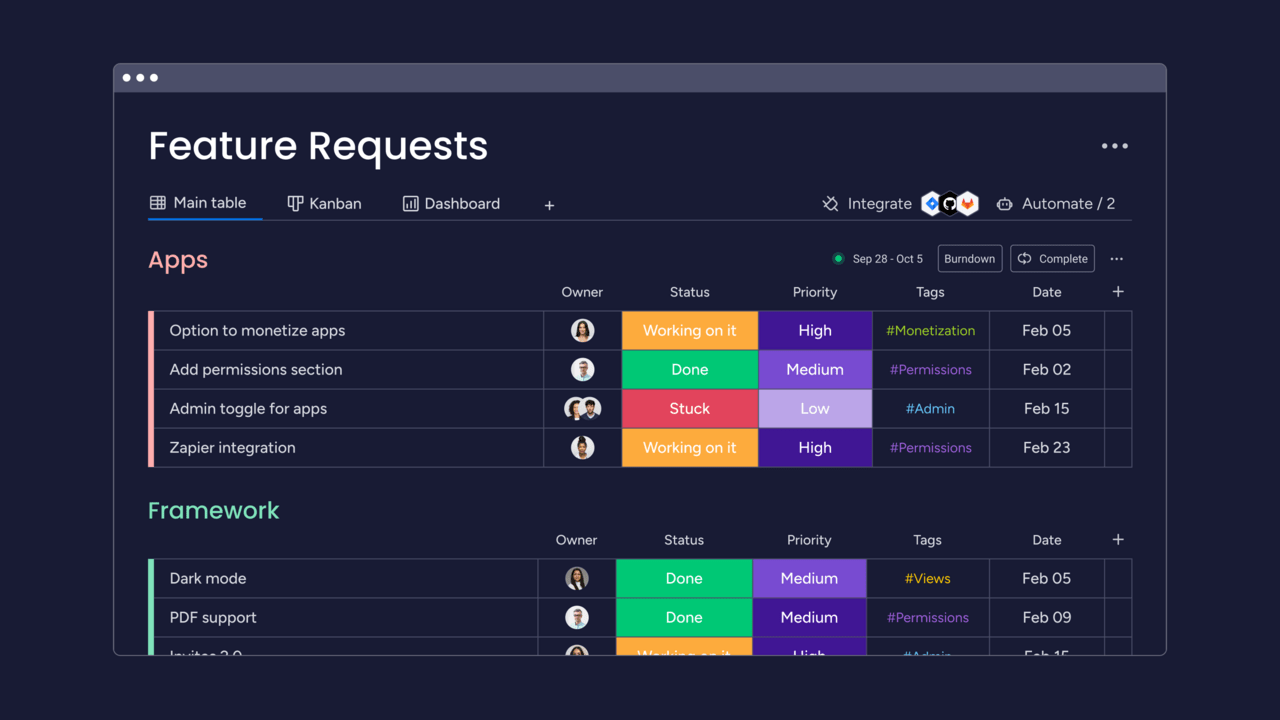
This real-time updating helps keep the sprint on track and ensures that all team members are aligned with the sprint’s progress and deadlines, thereby reducing bottlenecks and enhancing team efficiency.
Increment tracking: Leverage monday dev’s dashboard and timeline views to visually track the completion of product Increments. Dashboards can be customized to show the progress of current sprint tasks against the planned goals, offering a clear view of what was achieved and what needs more attention.
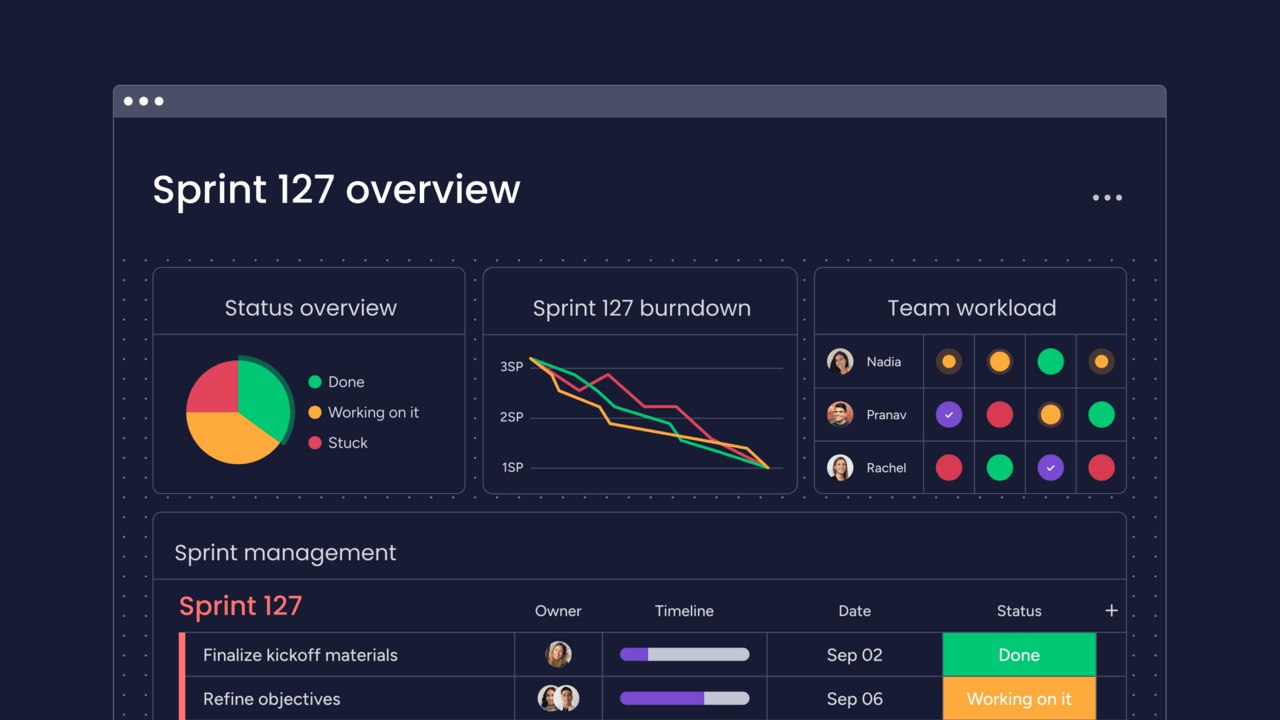
This visual representation helps present the increment to stakeholders and aids in assessing the quality and completeness of the work done, facilitating better release planning and continuous improvement.
Key monday dev features for Scrum artifact management:
- Sprint Planning & Automations: Keep your team synchronized with automated task assignments and status updates
- Advanced Kanban: Visualize your sprint backlog and track progress in real-time with a Scrumban approach.
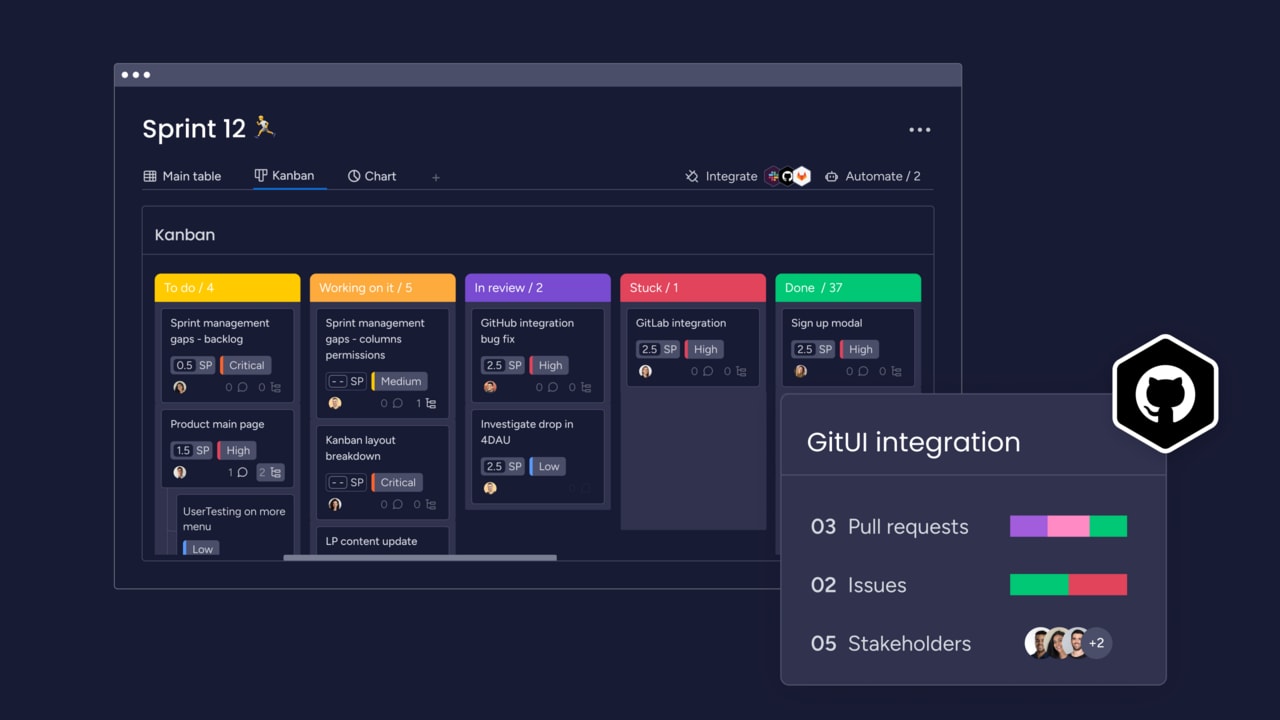
- Customizable Fields: Add story points, priority levels, and other relevant information to backlog items
- Burndown Charts: Monitor sprint progress and identify potential roadblocks early with burndown tracking.
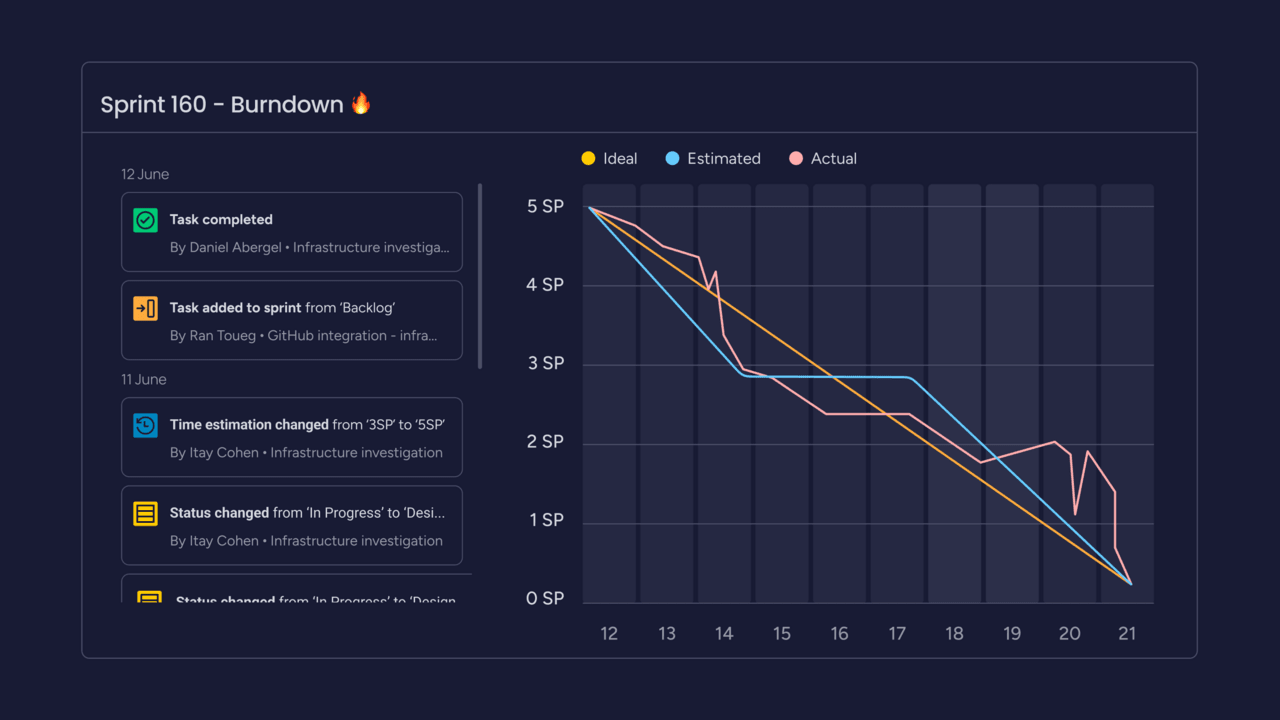
- Integrations: Connect with tools like GitHub, GitLab, and Figma for a seamless development workflow.
Real-world success: Luxie Tech’s transformation with monday dev
Luxie Tech, a fast-growing tech integration company, faced communication chaos and project delays as they scaled. monday dev transformed their workflow, streamlining Scrum artifact management and automating processes.
The results were impressive:
- 30% increase in project capacity
- 7% revenue boost in the first quarter
Luxie Tech’s success proves that effective Scrum artifact management with the right tools directly impacts business outcomes.
Don’t let inefficient artifact management hold your Scrum team back. Try monday dev today and experience the difference in your product development cycle. From seamless sprint planning to efficient execution and insightful retrospectives, monday dev is your partner in agile excellence.
FAQs
What are the six Scrum principles?
The six Scrum principles guide teams towards effective product development:
1. Empirical Process Control: Make decisions based on observation and experience, not just planning.
2. Self-organization: Empower teams to manage their own work and processes.
3. Collaboration: Foster close teamwork and frequent communication.
4. Time-boxing: Set fixed time periods for work to maintain focus and drive progress.
5. Value-based Prioritization: Focus on delivering high-value items first.
6. Iterative Development: Build products incrementally, learning and adjusting along the way.
These principles work together to create a framework that promotes transparency, inspection, and adaptation throughout the development process. By following these principles, teams can maintain flexibility, improve efficiency, and consistently deliver value to stakeholders.
How does Scrum differ from other Agile methodologies like Kanban or XP?
While Scrum, Kanban, and XP (Extreme Programming) are all Agile methodologies, they have distinct characteristics. Scrum focuses on fixed-length iterations called sprints, defined roles, and specific Scrum ceremonies. Kanban emphasizes continuous flow, limits work in progress, and doesn't have fixed iterations. XP concentrates on engineering practices like pair programming and test-driven development.
What's the difference between a Product Owner and a Project Manager in Scrum?
In Scrum, the Product Owner is responsible for maximizing product value, managing the product backlog, and defining product vision. The role of Project Manager doesn't exist in Scrum. Instead, the Scrum Master facilitates the process, and the team is self-organizing. Monday dev's role assignment feature can help you clearly define responsibilities within your Scrum team.
How do you handle unexpected work or emergencies during a Sprint?
When handling emergencies in a Sprint, first assess the urgency and impact. If critical, the Product Owner may choose to terminate the sprint. For less critical issues, add them to the product backlog for future sprints. It's best to avoid adding new work to the current sprint unless absolutely necessary.
What's the ideal team size for a Scrum team?
The ideal Scrum team size is typically 5-9 members, including the Product Owner and Scrum Master. This size balances collaboration and coordination efficiency.
How do you measure Scrum success?
You can measure Scrum success through velocity and sprint goal achievement, product quality and customer satisfaction, team morale and collaboration, adaptability to change, and continuous improvement in processes.
Can Scrum be scaled for larger organizations or multiple teams working on the same project?
Yes, Scrum can be scaled using frameworks like Scrum of Scrums, LeSS (Large-Scale Scrum), and SAFe (Scaled Agile Framework). These approaches help coordinate multiple Scrum teams working on the same project or within large organizations.
What's the role of QA in a Scrum team?
In Scrum, QA is integrated into the development process. QA professionals are part of the cross-functional team, contribute to defining the "Definition of Done", perform testing throughout the sprint (not just at the end), and help create and maintain automated tests.
How do you handle dependencies between different Scrum teams?
Managing dependencies involves identifying them early in sprint planning, using a dependency board or matrix, holding regular cross-team synchronization planning meetings, encouraging communication between dependent teams, and considering the use of a scaling framework for complex projects.
What's the difference between a Sprint Goal and a Product Goal?
A Sprint Goal is a short-term objective for a single sprint, focusing on a specific increment of work. In contrast, a Product Goal is a long-term vision for the product, providing direction for multiple sprints and the overall product development.
 Try monday dev
Try monday dev 


